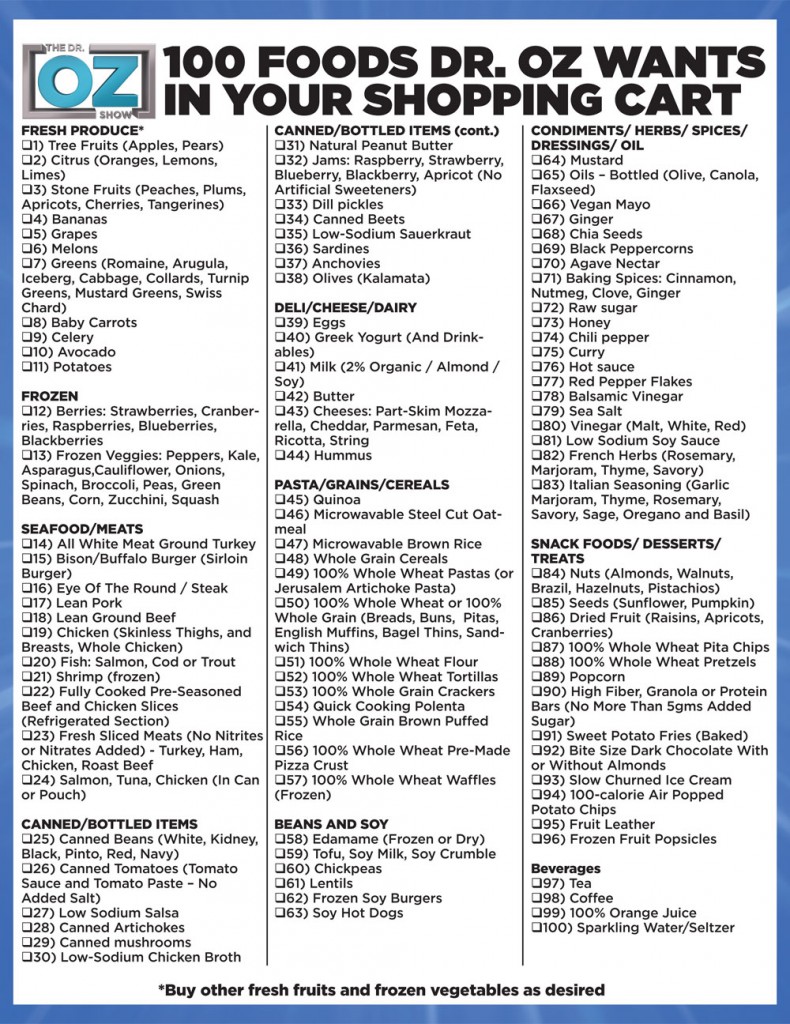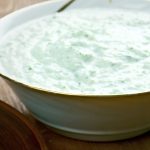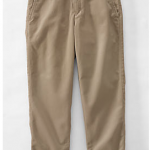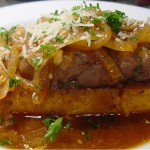Healthy Family Grocery List
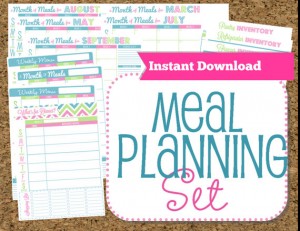 Plan your meals. Map out an entire week’s worth of meals before you go grocery shopping. It might sound like a lot of work on the front end, but planning will actually save you time, and money on the back end. You’ll have all the ingredients you need for the week, and some ingredients can actually serve double duty. Roast a whole chicken on Monday night, and you’ll have chicken salad sandwiches and chicken soup for Tuesday and Wednesday. Here is a downloadable meal planner from etsy.com. Or check out Dr. Oz’s shopping list (Click HERE to see the printable list). Try Ziplist, you can create a free, customizable, online shopping lists and search Ziplist’s extensive meal planning database. Once you’ve found a recipe you like, you simply click, and all the necessary ingredients will be automatically added to your shopping list. Ziplist also offers free apps for both iPhone and Android users, which will fully sync with your online account.
Plan your meals. Map out an entire week’s worth of meals before you go grocery shopping. It might sound like a lot of work on the front end, but planning will actually save you time, and money on the back end. You’ll have all the ingredients you need for the week, and some ingredients can actually serve double duty. Roast a whole chicken on Monday night, and you’ll have chicken salad sandwiches and chicken soup for Tuesday and Wednesday. Here is a downloadable meal planner from etsy.com. Or check out Dr. Oz’s shopping list (Click HERE to see the printable list). Try Ziplist, you can create a free, customizable, online shopping lists and search Ziplist’s extensive meal planning database. Once you’ve found a recipe you like, you simply click, and all the necessary ingredients will be automatically added to your shopping list. Ziplist also offers free apps for both iPhone and Android users, which will fully sync with your online account.
Organize your grocery shopping list by aisle. Follow these tips for filling that list with the healthiest foods from each aisle.
Bakery and Bread
– Whole-wheat bread, pita pockets, and English muffins
– Whole-grain flour tortillas
– Choose whole-grain breads that contain at least 4 grams of fiber and have fewer than 100 calories per slice.
Meat and Seafood
– Skinless chicken or turkey breasts
– Ground turkey or chicken
– Salmon, halibut, trout, mackerel
– Reduced-sodium lunch meat (turkey, roast beef)
– If you buy red meat, choose the leanest cuts — ones with very little visible marbling.
Pasta and Rice
– Brown rice
– Whole-wheat or whole-grain pasta
Oils, Sauces, Salad Dressings, and Condiments
– Tomato sauce
– Mustard
– Barbecue sauce
– Red-wine vinegar
– Salsa
– Extra virgin olive oil or canola oil, nonfat cooking spray
– Jarred olives
– Hot pepper sauce
Cereals and Breakfast Foods
– Whole-grain or multi-grain cereals
– Steel-cut or instant oatmeal
– Whole-grain cereal bars
– Buy cereals and cereal bars that are high in fiber and low in sugar.
– Use berries, dried fruit, or nuts to add sweetness to your cereal.
Soups and Canned Goods
– Diced or whole peeled tomatoes
– Tuna or salmon packed in water
– Low-fat soups and broths
– Black, kidney, soy, or garbanzo beans; lentils, split peas
– Diced green chilies
Frozen Foods
– Frozen vegetables: broccoli, spinach, peas and carrots (no sauce)
– Frozen fruit: strawberries, raspberries, blueberries
– Frozen cooked shrimp
– Pre-portioned, low-fat ice cream or frozen yogurt
– Whole-grain waffles
– Whole-grain vegetable pizza
– Buy frozen vegetables to throw into soups, casseroles, and stews.
– Low-fat frozen yogurt blended with frozen fruit makes a quick, healthy smoothie.
Dairy, Cheese, and Eggs
– Skim or low-fat milk or soymilk
– Fat-free or low-fat yogurt
– Fat-free or low-fat cottage cheese
– Low-fat cheese or string-cheese snacks
– Eggs or egg substitutes
– Firm tofu
– Butter or spread (a variety that doesn’t contain hydrogenated oils)
Snacks and Crackers
– Whole-grain crackers
– Dried fruit: apricots, figs, prunes, raisins, cranberries
– Nuts: almonds, walnuts, peanuts (roasted and unsalted)
– Seeds: sunflower seeds, sesame seeds, whole or ground flaxseeds
– Peanut butter, almond, or soy butter
– Hummus
– Dark chocolate pieces (containing more than 70% cocoa)
Produce
– Fruit: bananas, apples, oranges, mangoes, strawberries, blueberries
– Vegetables: sweet potatoes, baby spinach, broccoli, carrot sticks
– Look for a large variety of colorful fruits and vegetables. They contain the most nutrients.
– Buy fruits and vegetables that are in season and locally grown. They taste better, and cost less.
– If you’re busy, buy pre-cut fruits and vegetables. They’re easier to cook with, and eat.
Drinks
– Unsweetened green and flavored teas
– Calcium-fortified orange juice
– Sparkling water

